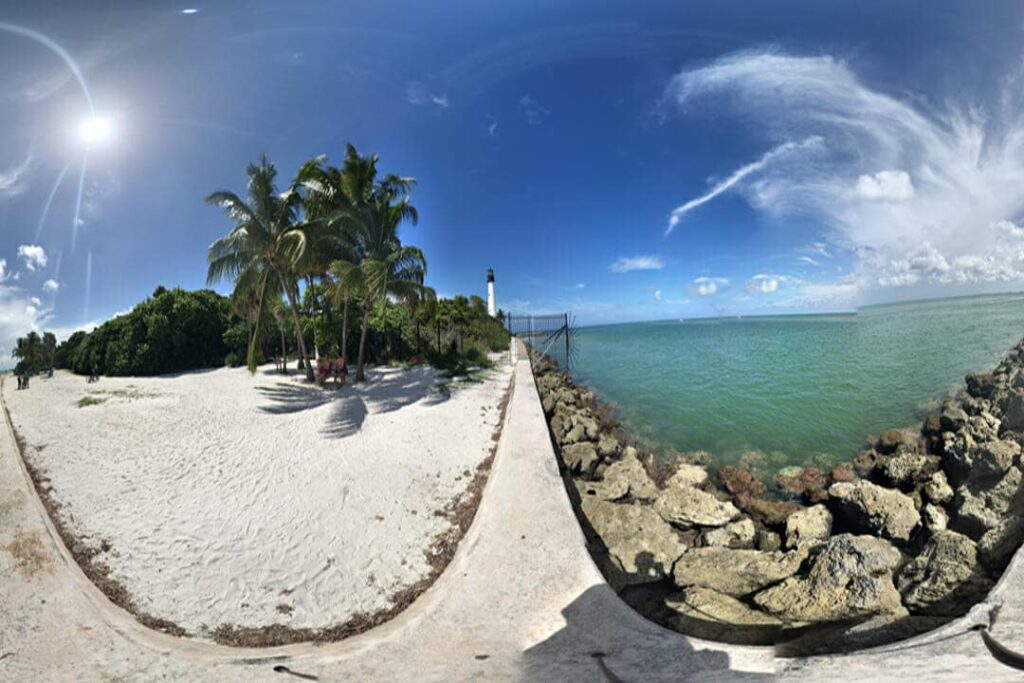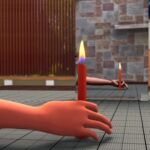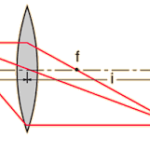As discussed in the previous section of Lesson 2, an image location is the location in space where all the reflected light appears to diverge from. Since light from the object appears to diverge from this location, a person who sights along a line at this location will perceive a replica or likeness of the actual object.
Virtual vs. Real Images
In the case of plane mirrors, the image is said to be a virtual image. Virtual images are images that are formed in locations where light does not actually reach. Light does not actually pass through the location on the other side of the mirror; it only appears to an observer as though the light is coming from this location. Whenever a mirror (whether a plane mirror or otherwise) creates an image that is virtual, it will be located behind the mirror where light does not really come from. Later in this unit, we will study instances in which real images are formed by curved mirrors. Such images are formed on the same side of the mirror as the object and light passes through the actual image location.
Apparent Left-Right Image Reversal
Besides the fact that plane mirror images are virtual, there are several other characteristics that are worth noting. The second characteristic has to do with the orientation of the image.  If you view an image of yourself in a plane mirror (perhaps a bathroom mirror), you will quickly notice that there is an apparent left-right reversal of the image. That is, if you raise your left hand, you will notice that the image raises what would seem to be it’s right hand. If you raise your right hand, the image raises what would seem to be its left hand. This is often termed left-right reversal. This characteristic becomes even more obvious if you wear a shirt with lettering. For example, a shirt displaying the word “NIKE” will read “EKIN” when viewed in the mirror; a shirt displaying the word “ILLINOIS” will read “SIONILLI;” and a shirt displaying the word “BOB” will read “BOB.” (NOTE: Not only will the order of letters appear reversed, the actual orientation of the letters themselves will appear reversed as well. Of course, this is a little difficult to do when typing from a keyboard.) While there is an apparent left-right reversal of the orientation of the image, there is no top-bottom vertical reversal. If you stand on your feet in front of a plane mirror, the image does not stand on its head. Similarly, the ceilingdoes not become the floor. The image is said to be upright, as opposed to inverted.
If you view an image of yourself in a plane mirror (perhaps a bathroom mirror), you will quickly notice that there is an apparent left-right reversal of the image. That is, if you raise your left hand, you will notice that the image raises what would seem to be it’s right hand. If you raise your right hand, the image raises what would seem to be its left hand. This is often termed left-right reversal. This characteristic becomes even more obvious if you wear a shirt with lettering. For example, a shirt displaying the word “NIKE” will read “EKIN” when viewed in the mirror; a shirt displaying the word “ILLINOIS” will read “SIONILLI;” and a shirt displaying the word “BOB” will read “BOB.” (NOTE: Not only will the order of letters appear reversed, the actual orientation of the letters themselves will appear reversed as well. Of course, this is a little difficult to do when typing from a keyboard.) While there is an apparent left-right reversal of the orientation of the image, there is no top-bottom vertical reversal. If you stand on your feet in front of a plane mirror, the image does not stand on its head. Similarly, the ceilingdoes not become the floor. The image is said to be upright, as opposed to inverted.
Students of Physics are usually quite intrigued by this apparent left-right reversal. Exactly what is happening to cause ILLINOIS to read as SIONILLI? And why is the reversal observed in the left to right direction and not in the head to toe direction? These questions urge us to ponder the situation more deeply. Let’s suppose for a moment that we could print the name of your favorite school subject on your shirt and have you look in the mirror. We all know that when you look in the mirror, you will see the letters SCISYHP written on the shirt of your image – the reversed form of PHYSICS. But can we really say that the word appearing on your shirt is the word PHYSICS (with the letters un-reversed)? The answer is no! (But you don’t have to believe it yet. Keep reading … and pondering.)
To further explore the reason for this appearance of left-right reversal, let’s suppose we write the word PHYSICS on a transparency and hold it in front of us in front of a plane mirror. If we look at the image of the transparency in the mirror, we would observe the expected – SCISYHP. The letters are written reversed when viewed in the mirror. But what if we look at the letters on the transparency? How are those letters oriented? When we face the mirror and look at the letters on the transparency, we observe the unexpected – SCISYHP. When viewed from the perspective of the person holding the transparency (and facing the mirror, the letters exhibit the same left-right reversal as the mirror image. The letters appear reversed on the image because they are actually reversed on the shirt. At least they are reversed when viewed from the perspective of a person who is facing the mirror. Imagine that! All this time you thought the mirror was reversing the letters on your shirt. But the fact is that the letters were already reversed on your shirt; at least they were reversed from the person who stands behind the T-shirt. The people who view your shirt from the front have a different reference frame and thus do not see the letters as being reversed. The apparent left-right reversal of an image is simply a frame of reference phenomenon. When viewing the image of your shirt in a plane mirror (or any part of the world), you are viewing your shirt from the front. This is a switch of reference frames.

Object Distance and Image Distance
A third characteristic of plane mirror images pertains to the relationship between the object’s distance to the mirror and the image’s distance to the mirror. For plane mirrors, the object distance (often represented by the symbol do) is equal to the image distance (often represented by the symbol di). That is the image is the same distance behind the mirror as the object is in front of the mirror. If you stand a distance of 2 meters from a plane mirror, you must focus at a location 2 meters behind the mirror in order to view your image.
Relative Size of Image and Object
A fourth and final characteristic of plane mirror images is that the dimensions of the image are the same as the dimensions of the object. If a 1.6-meter tall person stands in front of a mirror, he/she will see an image that is 1.6-meters tall. If a penny with a diameter of 18-mm is placed in front of a plane mirror, the image of the penny has a diameter of 18 mm. The ratio of the image dimensions to the object dimensions is termed the magnification. Plane mirrors produce images that have a magnification of 1.
In conclusion, plane mirrors produce images with a number of distinguishable characteristics. Images formed by plane mirrors are virtual, upright, left-right reversed, the same distance from the mirror as the object’s distance, and the same size as the object.
Flickr Physics Photo
The image of a candle as viewed in a plane mirror. The image has the same dimensions as the object and is the same distance behind the mirror as the object is in front of the mirror.

Check Your Understanding
1. You might have noticed that emergency vehicles such as ambulances are often labeled on the front hood with reversed lettering (e.g., ECNALUBMA). Explain why this is so.
See Answer

Most drivers will view the ambulance in their rear-view mirrors. As such, they will be viewing an image of the lettering. Such images appear with left-right reversal and so will be viewed with the proper orientation – AMBULANCE.
2. If Suzie stands 3 feet in front of a plane mirror, how far from the person will her image be located?
See Answer

Answer = 6 feet
Suzie (the object) is located 3 feet from the mirror. Suzie’s image will be located 3 feet behind the mirror. Thus, the distance between Suzie and the image will be 6 feet.
close
3. If a toddler crawls towards a mirror at a rate of 0.25 m/s, then at what speed will the toddler and the toddler’s image approach each other?
See Answer

Answer = 0.50 m/s
In one second, the toddler has moved towards the mirror by a distance of 0.25 meters. In the same second, the image will be 0.25 meters closer as well. Thus, the toddler and its image have become 0.50 meters closer in 1 second.


